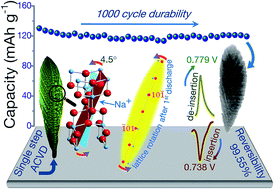Sustainable one step process for making carbon-free TiO2 anodes and sodium-ion battery electrochemistry†
Abstract
Electrodes with a carbon-free architecture impart a sustainable solution by eliminating side reactions. Such designs are required for anode systems, especially for sodium-ion batteries where the capacity contribution from carbon is noticed. Herein, carbon-free TiO2 is prepared in the monolithic dendritic form via a facile single-step aerosol vapor deposition technique, grown onto a stainless steel current collector. The single crystalline nature of the anatase dendrites explicitly provides detailed crystallographic analysis. Herein, we have realized an escalation of the rutile phase with the existing anatase phase upon cycling, which is depicted as a moiré pattern, while evaluating the structure through TEM studies. As the anode is carbon and binder-free, the overall material is electrochemically active, and hence appreciably improves the volumetric energy-density. Here, we observe a long cycle life of 1000 cycles from the additive-free anatase dendrites with an adequate capacity retention of 85.1%. Therefore, we believe that our single-step fabrication process to procure additive-free monolithic electrodes is a forthcoming paramount technique to produce sodium-ion batteries on mass.



 Please wait while we load your content...
Please wait while we load your content...
